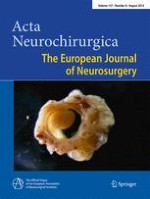Published in:

01-08-2015 | Clinical Article - Spine
Comparison of pulsatile and static pressures within the intracranial and lumbar compartments in patients with Chiari malformation type 1: a prospective observational study
Authors:
Radek Frič, Per Kristian Eide
Published in:
Acta Neurochirurgica
|
Issue 8/2015
Login to get access
Abstract
Background
In Chiari malformation type 1 (CMI), the obstruction of cerebrospinal fluid (CSF) flow through the foramen magnum is believed to cause alterations of intracranial pressure (ICP) pulsations. Foramen magnum decompression (FMD) is therefore considered a treatment of choice. However, the pathophysiology of CMI is poorly understood and it remains unknown how ICP alterations relate to symptoms and radiological findings. This study was undertaken to measure pulsatile pressure and its gradient between intracranial and lumbar compartments, and to determine its relationship to clinical and radiological findings.
Method
In patients with symptomatic CMI, we simultaneously measured ICP and lumbar CSF pressure, with particular focus on analysis of pulsatile pressure. Ventricular CSF volume (VV), intracranial volume (ICV) and posterior cranial fossa volume (PCFV) were calculated using volumetry software.
Results
In 26 patients (median 35 years), we found clearly abnormal or borderline values of pulsatile ICP in 18/26 patients (69 %; median 4.5 mmHg) and abnormal pulsatile pressure gradient in 17/24 patients (71 %; median 2.6 mmHg). The correlation between pulsatile ICP and the pulsatile pressure gradient was significantly positive (p < 0.001). We found no significant correlation between pulsatile or static pressure and extent of tonsillar ectopy, VV, ICV or PCFV. The pulsatile pressure gradient was significantly higher in patients with syringomyelia (p = 0.02).
Conclusions
In this cohort, the pulsatile ICP was elevated in 69 %. The intracranial-lumbar pulsatile pressure gradient was abnormal in 71 % and significantly higher in patients with syringomyelia. The elevated pulsatile ICP significantly correlated with pulsatile pressure gradient; no similar correlation was found for static ICP. We interpret the results as providing evidence of impaired intracranial compliance as an important pathophysiological mechanism in CMI.





